
Features
Cranes
Lifting Equipment
Keeping the work going, whatever the tide
July 14, 2022 By Don Horne
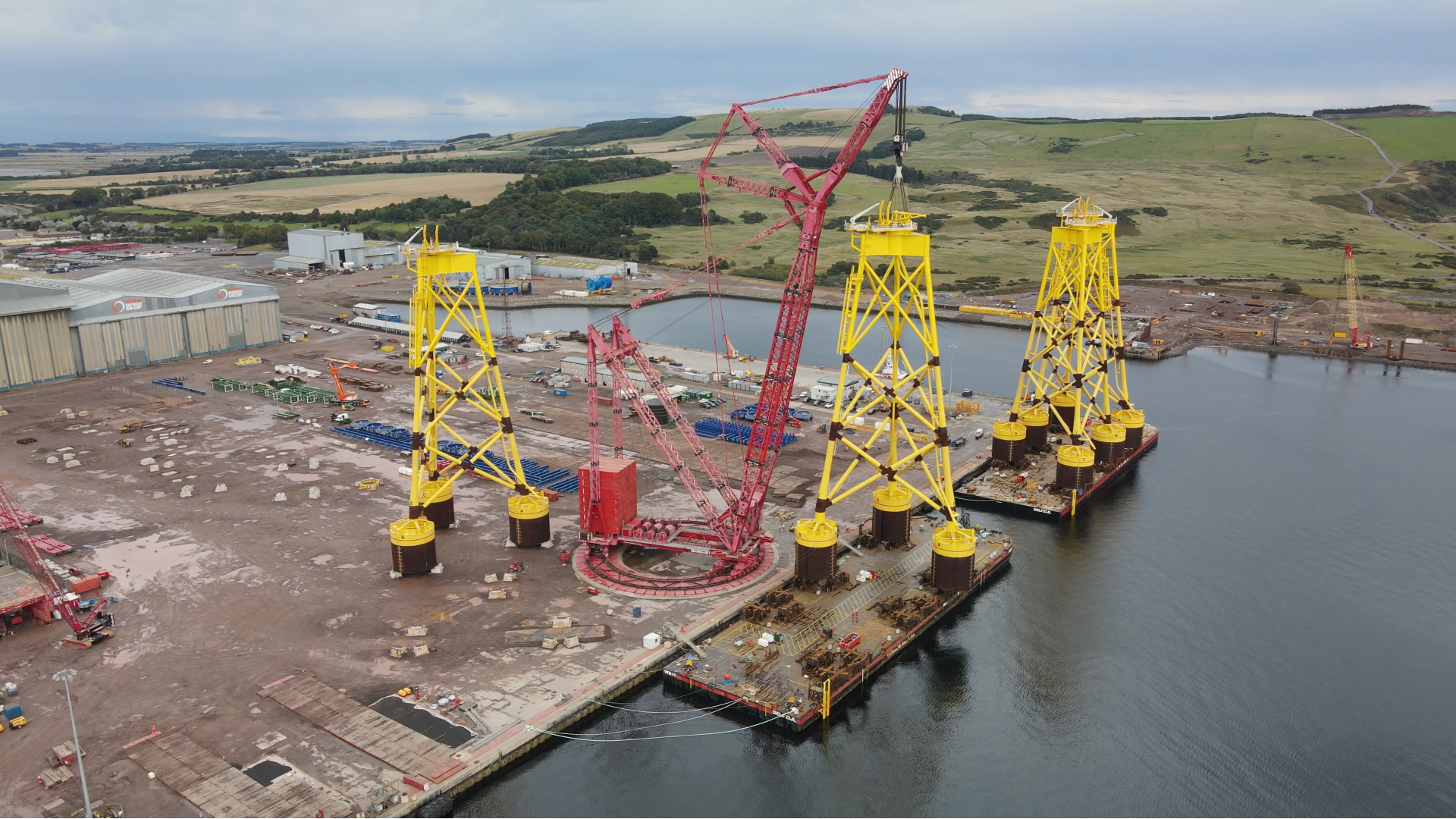
Offshore wind projects taking place in macrotidal environments must deal with water level changes of more than four metres every six hours. This extreme tidal range is difficult to compensate for using ballasting, so projects that require load-in or load-out of large jackets are delayed when waters are too high or low, leaving the installation vessel waiting.
This was the challenge facing Global Energy Group at the Port of Nigg, Scotland, a marshalling facility for Seagreen Offshore Wind Farm. Working years in advance, Mammoet proposed a large ring crane solution that would allow maneuvers to take place regardless of the tidal conditions, and so reduce the downtime of offshore assets and help to deliver first power as scheduled.
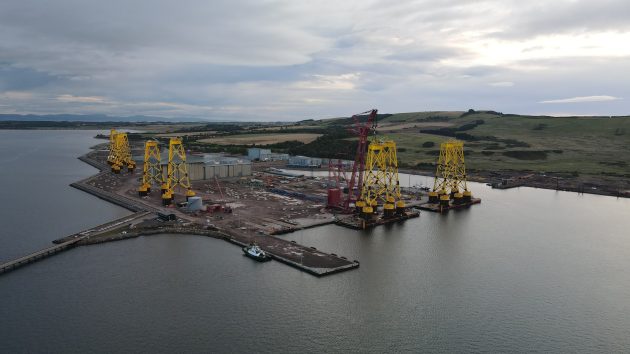
Seagreen will be the world’s deepest fixed bottom offshore wind farm, lying further from the coast where winds are stronger and more reliable. As a result, its 114 wind turbine foundation jackets stand 95m tall, and are robust enough to support new 10MW variants of Vestas turbine. Once it becomes operational in 2023, the facility will be capable of powering two-thirds of Scotland’s population.
From day one, the challenge was on to find a marshalling methodology that would keep the project’s most critical asset – its installation vessel – as productive as possible. To do this, the team would need to look beyond the jacket handling scope and determine how all scopes could be optimized to protect the critical path of the installation campaign.
The conventional approach to a project such as this would be to mobilize a fleet of SPMTs, then use these to complete all maneuvers – in fact, this was the initial plan. Though this may be the most obvious solution, it actually imposes many limitations on how the work can be performed, giving rise to hidden costs. With 114 jackets to load-in and load-out, these would quickly add up.
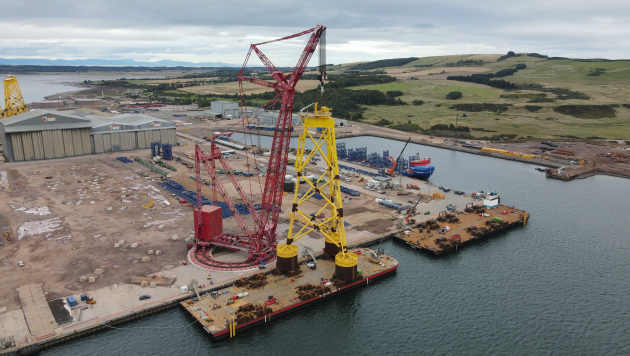
For example, while ballasting can be used to overcome changing water levels, if the tidal range is too large then the required barge height cannot be maintained, and the operational window is ‘closed’. Put simply, the number of days that transport equipment is usable can be far fewer than the number of days it is on site.
Also, if SPMTs need to drive on and off the barge, then deck space needs to be permanently cleared. This limits the area available for stowing the jackets, grillage beams and sea fastening. Larger and stronger barges can overcome these limitations, but this reduces size of the fleet that can be used for the project, causing supply chain issues and driving up project costs.
Having been involved with the project since 2018 and sharing a close working relationship with its customer Global Energy Group, Mammoet’s engineers were able to look beyond just the heavy transport scope. This allowed them to provide a more efficient alternative to SPMT transport.
The solution: using a combination of SPMT transporters and the PTC 210 DS ring crane.
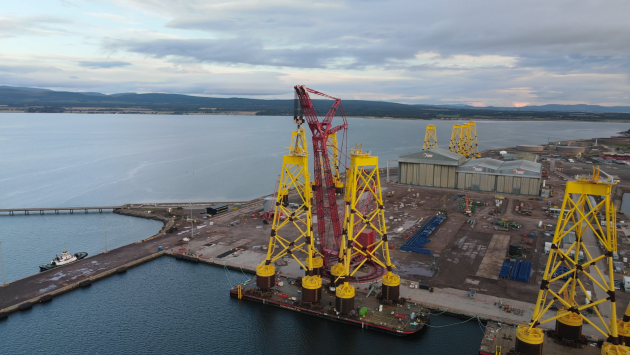
This approach completely removed the impact of tidal shifts on the project schedule, increasing the length of each load-out window. The five-hour operational time that would be expected for an SPMT load-out of this nature typically allows for only a single maneuver per shift, as once a first movement is complete, tide conditions prevent another from taking place. Crane lifting has no such limits as the barge deck no longer needs to remain level with the quay.
The ring crane also enabled smooth parallel operations, as it could load-out jackets to a waiting vessel while SPMTs offloaded others. Outside the delivery windows, jackets could be brought to the quayside, within lifting range of the crane, well in advance of a vessel arriving from offshore, cutting down significantly on crane waiting time and so maximizing the output of the installation vessel.
Where it takes roughly one shift to load each jacket using SPMTs – even if conditions are good – the PTC 210 DS is capable of loading-out two jackets in a single shift, providing barges are ready for it. This accelerates the pace of work significantly, increasing the feeder vessel cycle time and reducing downtime for the installation vessel at sea.
So it was that Mammoet’s operational teams found themselves at Nigg Energy Park near Inverness, working to make this vision a reality. In separate phases they would load-in, store, and load-out these 2,200t giants, in batches of two.
Was the decision to use a large ring crane a simple one?
“No, not at all,” says Mammoet UK Technical Sales Manager Oliver Smith. “As ever, when an organization is deciding on a project of this scale, cost-efficiency is always an important factor. We were involved with this project years in advance – well before some of the full details came to light. It was only further down the line that we needed to reassess the situation and move away from SPMT-only operations.”
He continues: “This change in plan wasn’t small either; we knew that our customer would in turn need to secure buy-in from their customer that the proposed solution would deliver results.”
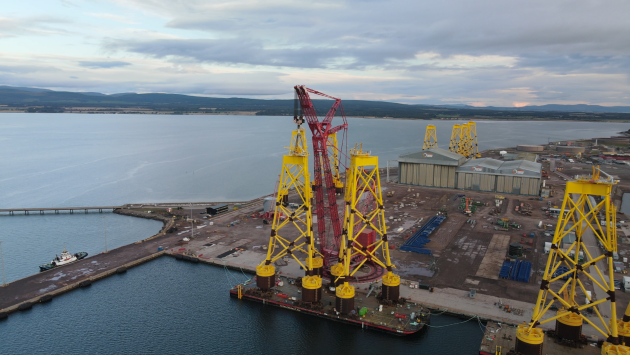
All photos courtesy of Mammoet.
How did we achieve this? We integrated engineering teams to demonstrate the flexibility of the solution and work through the risk, while in parallel, we were working with our customer on the commercial calculations, proving that the numbers did indeed add up.”
With the plans agreed and finalized, the loading operation commenced in July 2021 when the first jackets were delivered to Nigg Energy Park, loaded-in using SPMTs, then offloaded and stored in their pre-positioned blocking arrangement on-site.
In September 2021, the jackets were lifted from this arrangement and transferred to the quay edge via SPMT, and from there were loaded onto the feeder barges using the PTC 210 DS ring crane. They were then tugged to the installation vessel and installed 27km from the coast of Angus by the project’s engineering, procurement, construction and installation (EPCI) contractor, Seaway 7.
According to Smith, everything has proceeded as planned and prepared, and the feedback from Global Energy Group and other stakeholders has been positive:
“We knew this method was safe, flexible and more cost-effective than using SPMTs. Now we can share it with the wider industry so it can serve as a template for how to get offshore wind infrastructure in the water faster and more cost-efficiently; especially where tidal variances are high.”
Print this page